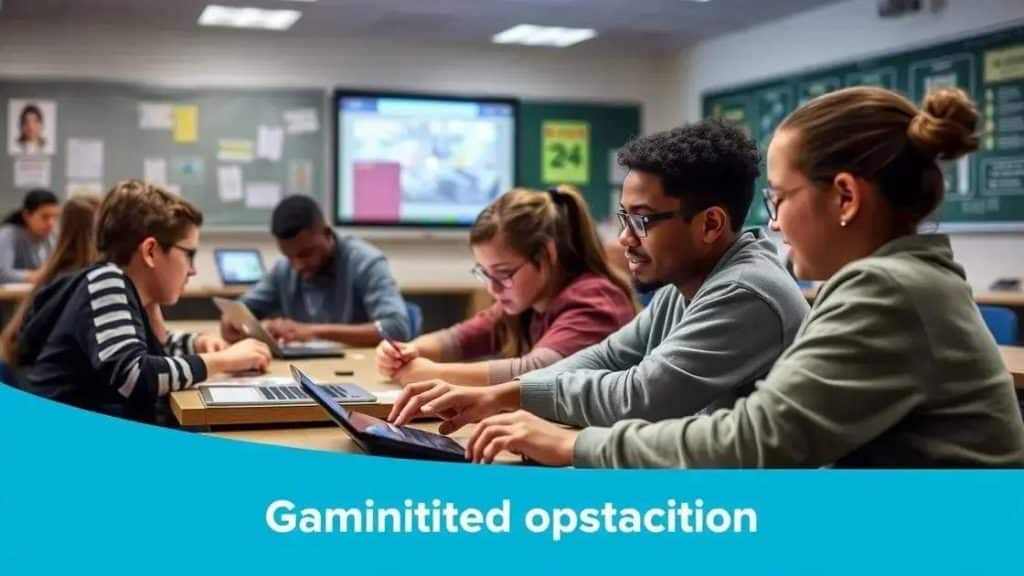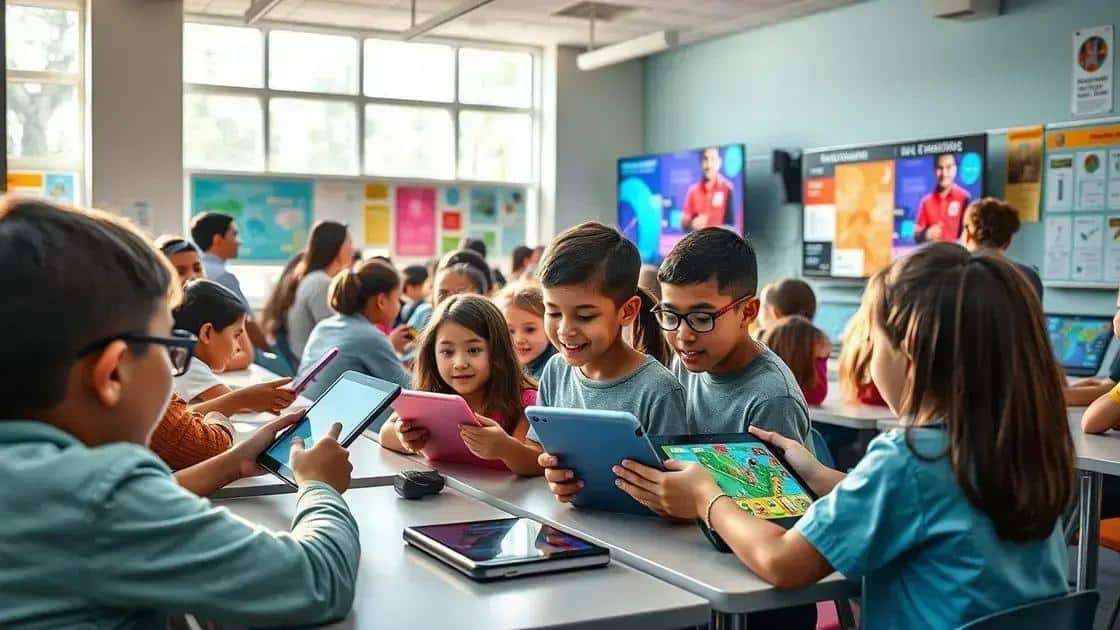Insights on gamified learning platforms: Unlocking potential

Gamified learning platforms enhance student engagement and retention by integrating game elements like points and rewards into educational experiences, as demonstrated by successful examples such as Duolingo and Classcraft.
Insights on gamified learning platforms show a burgeoning trend in education where game-like elements boost engagement. Have you ever wondered how they can transform traditional learning methods?
Understanding gamified learning platforms
Understanding gamified learning platforms is essential for improving education. These platforms integrate game mechanics and elements into the learning process to boost engagement and retention. By making learning fun and interactive, educators can reach students more effectively.
What are gamified learning platforms?
Gamified learning platforms use game design elements in non-game contexts. They often include features like points, badges, and leaderboards to motivate learners. This approach encourages students to participate actively in their education.
Key features of gamified platforms
- Interactivity: Students engage with content through quizzes, challenges, and interactive lessons.
- Feedback: Immediate feedback is provided, helping students understand mistakes and improve.
- Motivation: Achievements and rewards drive students to complete tasks and learn more.
By incorporating gaming elements, these platforms create an immersive learning environment that captures the attention of learners. For instance, students might earn points for completing homework, which can lead to rewards or the ability to unlock new content. This creates a sense of achievement and encourages continued participation.
As technology evolves, gamified learning platforms are becoming more sophisticated. They often utilize adaptive learning technologies to tailor experiences to individual student needs. This means that students can progress at their own pace, making the learning experience more personalized.
Benefits of using gamified learning
Utilizing these platforms offers various advantages:
- Enhances student engagement.
- Improves knowledge retention.
- Encourages teamwork and collaboration.
In summary, understanding gamified learning platforms reveals their power in transforming education. By implementing these tools, educators can create a more dynamic and effective learning experience.
Benefits of gamified learning

The benefits of gamified learning are significant and can transform how students engage with their education. By integrating game mechanics into the learning process, students are not only motivated but also more likely to retain information.
Increased Engagement
One primary advantage of gamified learning is its ability to boost student engagement. Traditional learning methods can often be dull, leading students to lose interest quickly. However, gamified platforms keep attention by providing interactive elements that make lessons fun.
Enhanced Motivation
Gamified learning also enhances motivation levels among students. By achieving rewards for completing tasks, learners feel a sense of accomplishment. This can lead to a healthier classroom environment where students strive to improve and compete, not just against others but against their personal best.
- Immediate Feedback: Students receive instant feedback on their performance, allowing for quick adjustments and learning from mistakes.
- Goal Setting: Gamified platforms encourage setting specific goals. This fosters a sense of direction and purpose in learning.
- Collaboration and Social Interaction: Many gamified learning tools promote teamwork, helping students develop collaboration skills.
In addition to engagement and motivation, gamified learning promotes critical thinking. Students often face challenges that require them to think critically and solve problems creatively. This skill is invaluable in real-life situations where logical thinking and decision-making are essential.
Moreover, gamified learning platforms can cater to diverse learning styles. Some students may thrive in competitive environments, while others may prefer collaborative settings. By offering various challenges and activities, gamified platforms provide opportunities for all types of learners to succeed.
Improved Retention
Research has shown that learners retain more information when they are involved in active, engaging activities. Gamification helps solidify knowledge through practice and repetition in an enjoyable way. This makes the knowledge more memorable and applicable.
How to choose the right platform
Choosing the right platform for gamified learning is a crucial step for educators and institutions. With so many options available, it’s important to evaluate features that will best meet the needs of students.
Identify Your Goals
First, determine what you want to achieve with gamified learning. Are you looking to enhance student engagement, improve retention, or provide a collaborative environment? Knowing your goals will help narrow down your options and find the best fit.
Evaluate Key Features
When comparing different platforms, consider their key features that align with your objectives. Some important elements to look for include:
- Customization: The ability to tailor the platform to your curriculum is essential for effective learning.
- Analytics: Access to data on student performance can help you understand how well the platform is working.
- Integrations: Ensure the platform works well with other tools you are already using in your classroom.
In addition to features, looking at user-friendliness is vital. Students should navigate the platform easily without feeling overwhelmed by complex interfaces. A simple and engaging design can make a significant impact on their learning experience.
Another aspect to consider is the support and resources provided by the platform. Check if there are tutorials, customer service, or training available for educators and students. This support can make the transition smoother and more effective.
Consider Student Feedback
Gathering feedback from students who have used the platform can provide valuable insights. Their experiences can help you understand if the platform enhances engagement and learning. Ask for their opinions on features they found helpful or any difficulties they encountered.
Ultimately, the right platform should align with your educational goals, offer the features you need, and be user-friendly. By carefully evaluating your options, you can create an effective gamified learning environment that benefits all students.
Real-world examples of successful gamification

Real-world examples of successful gamification show how effective these methods can be in various learning environments. Many organizations and schools have embraced gamified learning to improve engagement and outcomes.
Case Study 1: Duolingo
Duolingo is a popular language learning platform that uses gamification to motivate users. It incorporates elements such as points, badges, and a leveling system to encourage daily practice. Users earn rewards for completing lessons, which keeps them engaged over time.
Case Study 2: Classcraft
Classcraft transforms the classroom experience by turning learning into a game. Students create avatars and collaborate in teams to complete quests and earn rewards. This platform promotes teamwork and enhances classroom behavior, making learning more interactive and fun.
Case Study 3: Kahoot!
Kahoot! is another example of gamification in education, as it allows teachers to create quizzes that students can answer in real time. This fosters a competitive spirit while making learning enjoyable. Students are more likely to remember information when they participate in these exciting, game-like assessments.
- Engagement: All these platforms have successfully enhanced student engagement by incorporating game elements.
- Retention: Users retain more information through active participation and repetition in a fun environment.
- Adaptability: These platforms adapt to various learning styles, catering to different student needs.
By examining these examples, it’s clear that gamified learning can lead to improved educational outcomes. Organizations that implement these strategies often see increased motivation and participation from students.
Moreover, these successful cases highlight that gamification can be applied not only in traditional educational settings but also in corporate training and personal development. Companies use gamified approaches to train employees, making learning more engaging and effective.
FAQ – Frequently Asked Questions about Gamified Learning Platforms
What are gamified learning platforms?
Gamified learning platforms integrate game-like elements into the educational process to boost engagement and motivation.
How do these platforms improve student engagement?
By incorporating points, badges, and challenges, these platforms make learning interactive and enjoyable, keeping students interested.
Can gamified learning be used in corporate training?
Yes, many companies use gamification to train employees, making the process more engaging and effective.
What are some examples of successful gamified learning?
Examples include Duolingo for language learning and Classcraft for classroom management, both of which have shown improved outcomes.





